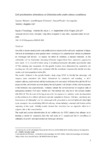Cell proliferation alterations in Chlorella cells under stress conditions

Use este enlace para citar
http://hdl.handle.net/2183/12495Coleccións
- Investigación (FCIE) [1232]
Metadatos
Mostrar o rexistro completo do ítemTítulo
Cell proliferation alterations in Chlorella cells under stress conditionsData
2009-09Cita bibliográfica
Rioboo C, O'Connor JE, Prado R, Herrero C, Cid A. Cell proliferation alterations in Chlorella cells under stress conditions. Aquatic Toxicology. 2009;94(3):229-37.
Resumo
[Abstract]Very little is known about growth and proliferation in relation to the cell cycle regulation of algae. The lack of knowledge is even greater when referring to the potential toxic effects of pollutants on microalgal cell division. To assess the effect of terbutryn, a triazine herbicide, on the proliferation of the freshwater microalga Chlorella vulgaris three flow cytometric approaches were used: (1) in vivo cell division using 5-,6-carboxyfluorescein diacetate succinimidyl ester (CFSE) staining was measured, (2) the growth kinetics were determined by cytometric cell counting and (3) cell viability was evaluated with the membrane-impermeable double-stranded nucleic acid stain propidium iodide (PI).
The results obtained in the growth kinetics study using CFSE to identify the microalgal cell progeny were consistent with those determined by cytometric cell counting. In all C. vulgaris cultures, each mother cell had undergone only one round of division through the 96 h of assay and the cell division occurred during the dark period. Cell division of the cultures exposed to the herbicide was asynchronous. Terbutryn altered the normal number of daughter cells (4 autospores) obtained from each mother cell. The number was only two in the cultures treated with 250 nM. The duration of the lag phase after the exposure to terbutryn could be dependent on the existence of a critical cell size to activate cytoplasmic division. Cell size, complexity and fluorescence of chlorophyll a of the microalgal cells presented a marked light/dark (day/night) cycle, except in the non-dividing 500 nM cultures, where terbutryn arrested cell division at the beginning of the cycle. Viability results showed that terbutryn has an algastatic effect in C. vulgaris cells at this concentration.
The rapid and precise determination of cell proliferation by CFSE staining has allowed us to develop a model for assessing both the cell cycle of C. vulgaris and the in vivo effects of pollutants on growth and reproduction at microalgal cell level.
Palabras chave
Herbicide
Viability
CFSE
Chlorella
Cell division
Flow cytometry
Proliferation
Viability
CFSE
Chlorella
Cell division
Flow cytometry
Proliferation





